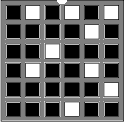| Sandorf's Cipher |
Count Mathias Sandorf, a hero of Jules Verne, encrypted the secret
messages of the Trieste conspirators by using a cipher key a
6![]() 6 hard paper square with some holes in it. In figure 1
the holes are marked white.
One edge of the cipher key has a
pinch-mark. Empty messages are coded as empty strings. For
encrypting a non empty message follow the Sandorf's algorithm
below.
6 hard paper square with some holes in it. In figure 1
the holes are marked white.
One edge of the cipher key has a
pinch-mark. Empty messages are coded as empty strings. For
encrypting a non empty message follow the Sandorf's algorithm
below.

Figure 1: Sandorf's cipher key
Real Programmers use Fortran. Quiche Eaters use Pascal.
is 55 characters long and has to be extended by appending 17
trailing #. Right after step 1, the message is:
#################.lacsaP esu sretaE ehciuQ .nartroF esu sremmargorP laeR
u#l# # geuhoc
as#r## raPir
ec##st sutrl
##aa## rQae o
EP# ## emFR .
#e#s. meanrs
which, when appended, yield the final encrypted message:
u#l# #as#r##ec##st##aa##EP# ## #e#s.geuhoc raPir sutrlrQae oemFR .meanrs
Real Programmers use Fortran. Quiche Eaters use
Pascal.
irdetn ihtoteao pesms soiaCet snaoi #e#r# edt#aasdrtltn ca reyor feneiv o#kginasksoaemlt f odatrnip as ene w#lerhiomfte t rSp se ntt.is id,raal o#r#i#etbanagvareioml nbfooheo lny e# #s#holp#lpt#iiok# w#so ts.tiis h H### ##d#l##a####n##o)##Dg#(##i#n#o#
Competition is a disease that sooner or later infects every trade and profession and makes it take a long step forward. Still, it remains the obligation of every honorable man to oppose it with his skills. (Donald Honig)